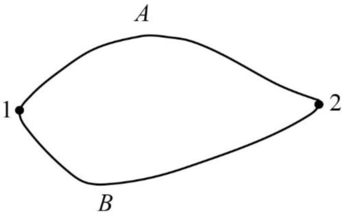
(a)
Show that the path independence of
(a)
Answer to Problem 4.25P
Showed that the path independence of
Explanation of Solution
Consider two paths A and B from point 1 to 2 as shown in the Figure below.

Write the expression for stoker’s theorem.
Let
Consider the Figure 1, this closed surface is denoted by
Use equation (II) in (III).
Conclusion:
Therefore, the path independence of
(b)
Show that Stokes’s theorem implies that
(b)
Answer to Problem 4.25P
Showed that Stokes’s theorem implies that
Explanation of Solution
Use equation (IV) in (I).
As
Conclusion:
Therefore, Stokes’s theorem implies that
(c)
Prove Stokes’s theorem.
(c)
Answer to Problem 4.25P
Proved Stokes’s theorem.
Explanation of Solution
Use
The value of
Rewrite the equation (VII) in rectangle plane.
When
Then rewrite the equation (VIII).
Write the expression for curl of a function.
Use equation (X) in
Solve the equation (XI).
From the equation (IX) and (XII), it is proved that Stokes’s theorem that is
Conclusion:
Therefore, Stokes’s theorem proved.
Want to see more full solutions like this?
Chapter 4 Solutions
Classical Mechanics
 College PhysicsPhysicsISBN:9781305952300Author:Raymond A. Serway, Chris VuillePublisher:Cengage Learning
College PhysicsPhysicsISBN:9781305952300Author:Raymond A. Serway, Chris VuillePublisher:Cengage Learning University Physics (14th Edition)PhysicsISBN:9780133969290Author:Hugh D. Young, Roger A. FreedmanPublisher:PEARSON
University Physics (14th Edition)PhysicsISBN:9780133969290Author:Hugh D. Young, Roger A. FreedmanPublisher:PEARSON Introduction To Quantum MechanicsPhysicsISBN:9781107189638Author:Griffiths, David J., Schroeter, Darrell F.Publisher:Cambridge University Press
Introduction To Quantum MechanicsPhysicsISBN:9781107189638Author:Griffiths, David J., Schroeter, Darrell F.Publisher:Cambridge University Press Physics for Scientists and EngineersPhysicsISBN:9781337553278Author:Raymond A. Serway, John W. JewettPublisher:Cengage Learning
Physics for Scientists and EngineersPhysicsISBN:9781337553278Author:Raymond A. Serway, John W. JewettPublisher:Cengage Learning Lecture- Tutorials for Introductory AstronomyPhysicsISBN:9780321820464Author:Edward E. Prather, Tim P. Slater, Jeff P. Adams, Gina BrissendenPublisher:Addison-Wesley
Lecture- Tutorials for Introductory AstronomyPhysicsISBN:9780321820464Author:Edward E. Prather, Tim P. Slater, Jeff P. Adams, Gina BrissendenPublisher:Addison-Wesley College Physics: A Strategic Approach (4th Editio...PhysicsISBN:9780134609034Author:Randall D. Knight (Professor Emeritus), Brian Jones, Stuart FieldPublisher:PEARSON
College Physics: A Strategic Approach (4th Editio...PhysicsISBN:9780134609034Author:Randall D. Knight (Professor Emeritus), Brian Jones, Stuart FieldPublisher:PEARSON





